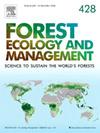Long-term sensitivity of ponderosa pine axial resin ducts to harvesting and prescribed burning
IF 3.7
2区 农林科学
Q1 FORESTRY
引用次数: 0
Abstract
Forest restoration treatments primarily aimed at reducing fuel load and preventing high-severity wildfires can also influence resilience to other disturbances. Many pine forests in temperate regions are subject to tree-killing bark beetle outbreaks (e.g., Dendroctonus, Ips), whose frequency and intensity are expected to increase with future climatic changes. Restoration treatments have the potential to increase resistance to bark beetle attacks, yet the underlying mechanisms of this response are still unclear. While the effect of forest restoration treatments on tree growth has been studied, less is known about their impact on resin-based defenses. We measured axial resin ducts in the earlywood and latewood of ponderosa pines (Pinus ponderosa) in western Montana, USA, 20 years before and after the implementation of restoration treatments, with the aim to elucidate changes in the yearly and interannual investment in resin duct defenses following treatments and their sensitivity to climate. Two experiments were established in 1992: a moderate thinning and a retention shelterwood, with 35 % and 57 % basal area reduction, respectively. Each experiment comprised four treatments with three replicates per treatment: cutting only, cutting followed by prescribed burning in either spring or fall or under wet or dry duff moisture conditions, and an untreated control. Cutting treatments stimulated a long-term, sustained increase in resin duct production, more pronounced in the earlywood, which we attribute to a higher availability of resources due to reduced tree density. Prescribed burning following cutting induced a short-term increase in resin ducts, likely aiding in the compartmentalization of fire-killed cambium and enhancing the resistance of fire-injured trees to bark beetle attack. However, the fire-induced spike in duct production was not related to the degree of crown scorch. Treatments had little effect on climate-defense relationships, as ducts remained positively correlated to winter precipitation and, though less significantly, negatively correlated to spring maximum temperature. Our findings show that by reducing stand density, forest restoration treatments induce the synthesis of resin ducts, which are key in mitigating vulnerability of ponderosa pine to mountain pine beetle (D. ponderosae) attacks, thus promoting forest resilience to multiple disturbances.
松柏轴向树脂导管对采伐和规定燃烧的长期敏感性
以减少燃料负荷和防止严重野火为主要目的的森林恢复措施也会影响对其他干扰的恢复能力。温带地区的许多松树林都会受到杀死树木的树皮甲虫(如 Dendroctonus、Ips)的侵袭,随着未来气候的变化,预计这种侵袭的频率和强度都会增加。恢复处理有可能增强对树皮甲虫攻击的抵抗力,但这种反应的基本机制仍不清楚。虽然人们已经研究了森林恢复处理对树木生长的影响,但对其对基于树脂的防御系统的影响却知之甚少。我们测量了美国蒙大拿州西部松柏(Pinus ponderosa)早材和晚材中的轴向树脂导管,这些树脂导管在实施恢复处理前后各20年的变化情况,目的是阐明恢复处理后树脂导管防御能力的年度和年际投资变化及其对气候的敏感性。1992 年进行了两项实验:中度疏伐和保留防护林,基部面积分别减少 35% 和 57%。每个实验包括四个处理,每个处理有三个重复:只砍伐、砍伐后在春季或秋季、潮湿或干燥的凝灰岩湿度条件下进行规定的焚烧,以及未处理的对照。砍伐处理刺激了树脂管产量的长期、持续增长,这在早材中更为明显,我们将其归因于树木密度降低导致资源供应增加。砍伐后的人工焚烧会引起树脂导管的短期增加,这可能有助于将被火烧死的骨架分隔开来,并增强被火烧伤的树木对树皮甲虫攻击的抵抗力。然而,火烧引起的导管产量激增与树冠烧焦程度无关。处理对气候-防御关系的影响很小,因为导管仍与冬季降水量呈正相关,与春季最高气温呈负相关(虽然不那么显著)。我们的研究结果表明,通过降低林分密度,森林恢复处理可以诱导树脂导管的合成,而树脂导管是减轻松柏易受山松甲虫(D. ponderosae)攻击的关键,从而促进森林对多种干扰的恢复能力。
本文章由计算机程序翻译,如有差异,请以英文原文为准。
求助全文
约1分钟内获得全文
求助全文
来源期刊

Forest Ecology and Management
农林科学-林学
CiteScore
7.50
自引率
10.80%
发文量
665
审稿时长
39 days
期刊介绍:
Forest Ecology and Management publishes scientific articles linking forest ecology with forest management, focusing on the application of biological, ecological and social knowledge to the management and conservation of plantations and natural forests. The scope of the journal includes all forest ecosystems of the world.
A peer-review process ensures the quality and international interest of the manuscripts accepted for publication. The journal encourages communication between scientists in disparate fields who share a common interest in ecology and forest management, bridging the gap between research workers and forest managers.
We encourage submission of papers that will have the strongest interest and value to the Journal''s international readership. Some key features of papers with strong interest include:
1. Clear connections between the ecology and management of forests;
2. Novel ideas or approaches to important challenges in forest ecology and management;
3. Studies that address a population of interest beyond the scale of single research sites, Three key points in the design of forest experiments, Forest Ecology and Management 255 (2008) 2022-2023);
4. Review Articles on timely, important topics. Authors are welcome to contact one of the editors to discuss the suitability of a potential review manuscript.
The Journal encourages proposals for special issues examining important areas of forest ecology and management. Potential guest editors should contact any of the Editors to begin discussions about topics, potential papers, and other details.
 求助内容:
求助内容: 应助结果提醒方式:
应助结果提醒方式:


